Uncover Aix-en-Provence's vibrant flavors and culinary gems with our expert guides. Plan an unforgettable trip now!
Read more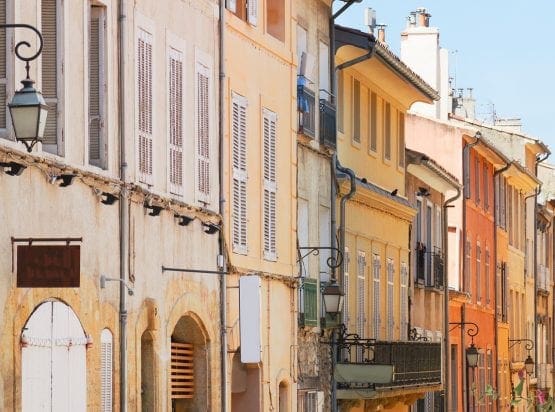
EXPLORE ALL OUR PROVENCE WINE REGIONS GUIDE
Last updated: April 4, 2025
Historically, people recognized Provence first and foremost as a luxury vacation destination, not as a source of quality wine. Since time immemorial, Provence has sold millions of bottles of ‘sun-kissed’ rosé – many of dubious quality, succeeding due to a suspension of critical faculties. When faced with Provence’s benign climate, gorgeous scenery, and excellent gastronomy, how many sybarites could claim to be in a critical mood?
Meanwhile, Bordeaux and Burgundy established reputations globally as fine wine regions, yet Provence did no such thing. Outside the tourist season, locals consumed wines with local dishes and did not promote them widely to the outside world.
This was Côtes de Provence in the 1990s. However, things look very different today: Soaring investment has transformed the region’s viticultural landscape and broadened its appeal, encouraging the production of saline whites, velvety reds, and rosé. This lightly colored—and very aromatic—tipple remains Provence’s most important export. But the region is no longer a one-trick pony, beholden to sun-seeking tourists. Papa’s got a brand new bag.
Discover More About French Wine
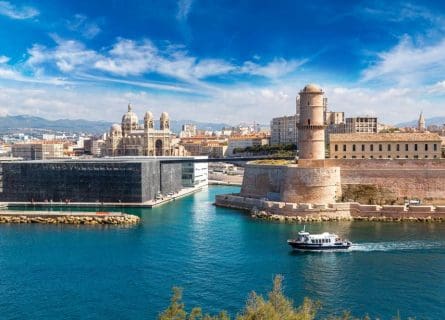
Côtes de Provence began life in 1951 as a Délimité de Qualité Supérieure (VDQS) – the authorities no longer recognize this designation. In 1997, authorities granted the region appellation status, although people have cultivated vines across Provence since ancient times.
The region’s first inhabitants reportedly used indigenous varieties to make wine before the Greeks arrived in Marseille in 600 BC. This ancient civilization naturally brought their winemaking traditions with them – soon, vines covered Provence’s spectacular landscapes.
The Romans continued this fine tradition after Julius Caesar led a successful invasion of Gaul (France) in the last century BC. Provincia Romana (modern-day Provence) was one of the Western Empire’s most cherished possessions, stretching from the southern reaches of the Alps to the vineyards of the Rhone. It was a glorious time for the Roman Empire.
The Dark Ages and Medieval Power Shifts
However, incursions from Germanic civilizations started to weaken Rome’s authority to the point of total collapse in the 5th century AD. The Visigoths, Vandals, and Ostrogoths were all intent on conquering Provence in the Dark Ages, but the might of the Frankish armies thwarted them.
Led by King Clovis I, the Franks organized a series of campaigns that ousted their competitors, consolidating their claim to the former Roman territory of Gaul. Yet eventually, their rivals, the Carolingians, usurped the Franks – a move that preceded the foundation of the Holy Roman Empire.
Over the centuries, the Catalans, Counts of Toulouse, House of Savoy, and the Sardinians all left their indelible mark on Provencal wine.
The Church’s Influence and the Phylloxera Crisis
Meanwhile, in the 1300s, the Catholic Church decided to leave its base in Rome and relocate to the sunny climes of Provence. After the papacy established headquarters in Avignon, religious orders became heavily involved in vine cultivation across southern France.
This continued despite the intense political shifts of the Middle Ages; in 1481, the French state absorbed Provence. Avignon and Carpentras, however, maintained their independence until the late 1700s. A century later, phylloxera, a poisonous louse accidentally imported from the US in the 19th century, devastated vineyards across the Mediterranean.
Fortunately, a major regrafting program (the only solution was to graft European vines onto resistant American rootstock) enabled a full recovery in the 20th century.
A Revolution in Wine Perception and Quality
Nevertheless, traditionally, people have viewed Provence through the prism of wine styles and individual estates, focusing little attention on specific regions or vineyard sites.
One notable exception occurred in 1955 when authorities awarded a ‘Cru Classe’ designation to 23 wine estates – now 18 – based on their perceived superior status. Overall, however, Provence dedicated itself to mass-producing forgettable rosé.
Thankfully, this captivating Mediterranean region has undergone a dramatic revolution over the past two decades. A raft of investment and a surge of new talent has upgraded quality across Provence’s appellations.
The quality of rosé made in the Côtes de Provence appellation has reached new heights, buoyed by the insatiable and increasingly year-round consumer demand.
Seriously exciting reds and racy, structured whites are now being made in the most hallowed terroirs, formerly ignored but now cherished. Today, Côtes de Provence is on a roll.
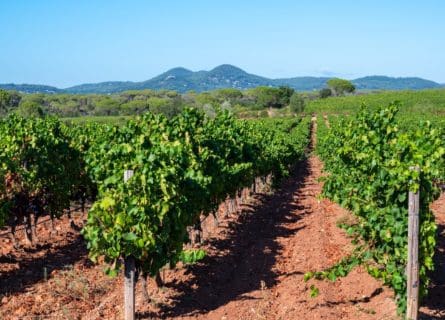
Côtes de Provence is the largest appellation in southeastern France, with over 20,000 hectares under vine. It is also unusual as the boundaries are non-continuous. Growers marketing wines under the appellation are located north of Marseille, on Mediterranean islands, around St-Tropez, in the sub-alpine retreats north of Draguignan, and in a small enclave around the area of Villars well north of Nice.
However, the central hub of Côtes de Provence is predominantly situated in the Var department, covering the eastern section of the Provence wine region. As a result, Côtes de Provence is perhaps France’s most heterogeneous viticultural zone.
Terroir Variability and Vineyard Characteristics
A mosaic of terroirs awaits the new investor, with microclimates, soil variations, and varying altitudes/aspects, all creating intriguing points of difference. Growers now recognize that the grape variety comes second to the unique characteristics of an individual vineyard plot or ‘climat.’ Local soils run the whole gamut, from sedimentary deposits of limestone to metamorphic soils – namely schist and quartz. Clay and sandstone dominate inland, while coastal areas typically have a higher concentration of metamorphic soils.
Climatic Conditions and Challenges
Climatically, the region enjoys one of Europe’s driest and sunniest weather patterns, responsible for attracting tourists year-round. Winters are mild, while summers have seen little rainfall in recent years – sometimes leading to hydric stress as vines shut down due to the intense heat and drought.
The most significant viticultural hazard in the appellation is overripeness. Winemakers must remain vigilant to avoid high pH and jammy, flabby wines.
Altitude: The Secret to Balance and Elegance
But growers have a secret weapon: altitude. Indeed, growers produce some of the best wines in Côtes de Provence from grapes grown in vineyards facing north, with proximity to the Mediterranean and higher elevations helping to maintain freshness and balance. This is due to a phenomenon known as diurnal temperature variation – a significant temperature difference between day and night.
In addition, strong mistral winds from the north can moderate heat and prevent rot, protecting vines that are not securely trained from damage. Exposed vineyards can pose problems, while, unlike in Burgundy, people often consider south-facing sites inferior terroirs due to the intense heat and lack of respite. This climate naturally provides fruit-forward, intense wines with little work; balance, elegance, and poise require a concerted effort in both the vineyard and the cellar.
Constituting over 70% of the region’s total production, rosé is the lifeblood of Côtes de Provence. Yet it is not a homogeneous category: styles, blends, price points, and quality varies enormously. Examples produced from old bush vines, cultivated at tiny yields and then subject to slow fermentation and maturation in barrique, are a world away from the “sunshine in a bottle” cliché.
Nevertheless, most producers favor a blend of three or four varieties, typically Grenache, Mourvedre, and Cinsault.
The classic method for making rosé involves leaving crushed or broken red grapes in contact with the skins for a short period before removing the must and fermenting it at low temperatures. This yields a very fresh and aromatic style of rosé. The lightness of color is simply derived from a brief maceration—grape coloring pigments are found in the skins.
Modern Vinification Techniques for Trendy Rosé
However, specific wineries eschew this approach, preferring to vinify the juice from berries almost immediately after they have been pressed. This produces a pale and fruity rosé wine: perfumed and very delicate. Such expressions are the height of fashion today, so this method is becoming more popular.
The Rising Stars
Meanwhile, critics are raving about the quality of dry whites and voluptuous reds. The best examples are complex, structured wines that boast a unique scent and taste of garrigue. The red grapes planted include Cabernet Sauvignon, Grenache, Syrah, Carignan, Cinsault, Mourvedre, and the local Tibouren.
A new generation of winemakers has proven that the terroir in Côtes de Provence can equal any vineyard in the Rhone. Seeking out the best sites and cultivating at low yields, vignerons are increasingly making excellent wines that, when tasted blind, convince buyers that they’re imbibing something exceptional – and expensive.
The Art of Blending
The best examples of winemaking in Côtes de Provence tend to be multi-grape concoctions rather than single-variety wines. The small volume of local whites also trades heavily on the value of blending, mixing, and matching Vermentino, Chardonnay, Grenache Blanc, Sauvignon Blanc, and Semillon.
Protective winemaking has been widely embraced in the appellation, with cool fermentations in stainless steel producing scores of fruit-driven, aromatically expressive wines. A good example is fresh and mouthwatering, with an attractive bouquet of apricots, lime, and garrigue.
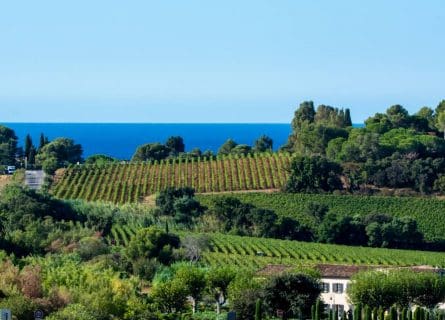
Côtes de Provence has become the sommelier’s favorite choice for excellent quality at reasonable prices. Some wine snobs may consider the appellation a poor choice compared to the (justifiably) exalted wines of the Rhone Valley, but Provence has finally shaken off its lackluster image. Indeed, the region makes life easy for oenophiles: it has a national flavor.
Although the range of grape varieties is quite large, many of the appellation’s best white and red wines are blends, involving Grenache, Carignan, Marsanne, and Vermentino – all staples of the Mediterranean.
This is good news for consumers seeking rich, garrigue-infused wines with plenty of fruit; the only issue is overripeness in the hotter parts of the zone.
Climate Change
Côtes de Provence may be winning awards monthly, but it should not be complacent. As elsewhere, the appellation’s succession of blisteringly hot and dry vintages has made climate change a significant talking point.
Proactive Environmental Efforts
Fortunately, producers in Cotes de Provence take global warming very seriously. Recent years have seen a concerted effort to reduce the environmental impact of wine growing; Provence now cultivates over 6600 hectares of organic vineyards, and approximately 10,000 hectares are certified as HVE (‘Haute Valeur Environnementale).
The region’s oversight body, Vins de Provence, has stated that it hopes to achieve 100% environmental certification by 2030 – a laudable goal. Experiments with heat-resistant varieties—including Calabrese and Greece’s Xinomavro—have also been conducted to see if these ‘interlopers’ can thrive on Provencal terrain.
Much credit for this innovation should go to the Center du Rosé, the only research institute in the world that focuses exclusively on the production of rosé wines. The center has played a vital role in encouraging reluctant growers to abandon synthetic inputs and sharing best practices and eco-friendly viticultural techniques.
Future of Côtes de Provence
This is why Côtes de Provence will thrive in the years ahead. Not only are boutique wineries producing terroir-driven wines of the highest caliber, but Provence is also safeguarding its future with a more sustainable paradigm that unites this diverse vineyard. In 2023, cheap and cheerful rosé is no longer the export banner. Cotes de Provence is striving for excellence and winning.
Bourboulenc is a white wine grape variety grown mainly in Southern Rhône, Provence, and Languedoc in southern France.
Find out moreSavor Clairette blanche, a captivating white wine grape from France's Chateauneuf-du-Pape, Provence, Rhône, and Languedoc vineyards
Find out moreGrenache blanc is a white wine grape varietal popular in the Rhône, Châteauneuf-du-Pape and Languedoc-Roussillon regions of Southern France.
Find out moreUncover the allure of Marsanne grape variety. From its traditional role in Rhône blends to the new wave of single-varietal Marsanne wines.
Find out morePascal Blanc is a rare, disease-sensitive white grape used in Cassis AOC wines, where it can make up to 40% of the blend. It thrives in Cassis' warm, dry climate and adds citrus, herb, and nutty flavors to the region's light, dry wines.
The sauvignon blanc grape varietal, originally from the Bordeaux region of France, is now one of the world's most loved white varieties.
Find out moreTerret Blanc is an old, high-yielding grape variety from southern France, once popular for Vermouth and dry whites. Its use has declined, but it's still permitted in certain French AOCs, contributing 10-30% to white wine blends. The grape produces light, crisp wines and is mostly confined to southern France.
Experience Trebbiano Toscano's Renaissance: Aromatic & Fresh Bianco Toscana IGT from Petrolo. The Future of Italian White Wine
Find out moreCarignan is a red grape variety that grows mostly in Southern France, and is often used as a blending grape
Find out moreCinsault is a red wine grape that is important in the Languedoc-Roussillon wine region of France because of its tolerance to high temperatures.
Find out moreDiscover grenache, a mediterranean grape that is dark-skinned red wine grape variety and an unlikely hero of a grape
Find out moreMourvèdre is a red wine grape variety of mysterious origin that's grown around the world, including the Rhone and Provence regions of France.
Find out moreSyrah is dark-skinned and perhaps the most underrated of the 'noble' red grape varieties.
Find out more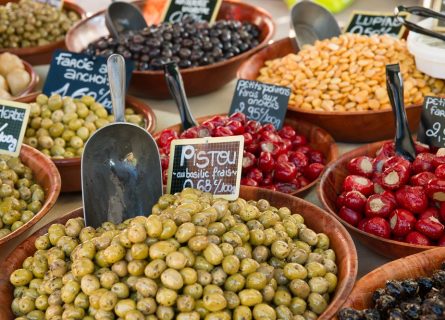
The Provencal cliches of garlic, olive oil, and sun-ripened tomatoes are widely available in this Mediterranean paradise. Yet we should remember that southern France has a considerable population of immigrants from North Africa – especially in Marseille.
As a result, an exceptional variety of reasonably priced Moroccan, Tunisian, and Algerian cuisine is available both in cities and smaller towns throughout Provence. One of the most delicious and easy-to-find favorites is tajine: slow-cooked pieces of meat braised alongside preserved lemons, prunes, and couscous.
Gastronomy Guide to the Cusine of Provence: Read more

Uncover Aix-en-Provence's vibrant flavors and culinary gems with our expert guides. Plan an unforgettable trip now!
Read more
Uncover Avignon's vibrant flavors and culinary gems with our expert guides. Plan an unforgettable trip now!
Read more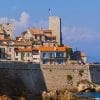
Uncover Antibes' vibrant flavors and culinary gems with our expert guides. Plan an unforgettable trip now!
Read more
Uncover Marseille's vibrant flavors and culinary gems with our expert guides. Plan an unforgettable trip now!
Read more
Uncover Orange's vibrant flavors and culinary gems with our expert guides. Plan an unforgettable trip now!
Read moreIf you would like us to customize an exclusive luxury tour, contact us and let us know your travel plans. We offer luxury food and wine tours for private groups of a minimum two guests. In addition, all of our private, chauffeured tours are available year-round upon request.

